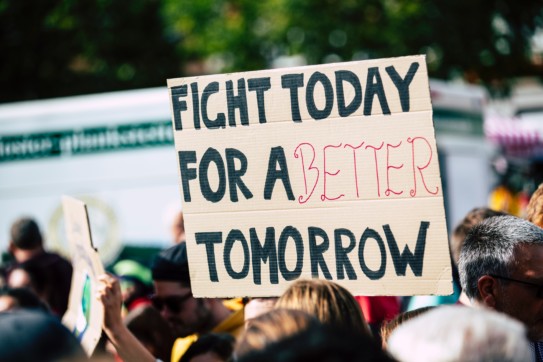Taking a Deeper Look at the “Social” Piece of ESG (Environmental Social Governance)

In our most recent white paper, “Exploring Environmental Social Governance” we include a section that picks apart the pieces of ESG, including a list of some of the items under the “social” category. From formal Diversity and Inclusion Programs to product responsibility and safety, the types of initiatives are wide-ranging.
As I looked a little deeper into social justice issues that companies try to address with their programs, I found that these initiatives can look vastly different around the globe. Different countries face different challenges when it comes to social justice. Some countries have more movements around racial equality or gender equality, while others have more movements around anti-corruption, education access, human rights or food insecurity. Companies that operate globally will need to approach social justice as it relates to the needs of their employees and communities around the world.
Many companies recognize the opportunity to develop long-term sustainability goals to address health, social and economic challenges as a part of the “social” element of ESG. (Want to see what this looks like in action? You can attend the upcoming ACCP webcast “Shifting Strategies for Global Community Engagement as a Result of the Pandemic” to learn from CSR leaders at Blackbaud, Dell and PIMCO on how they support communities facing the impacts of COVID-19. )
Another important component of the “social” element of ESG is social justice. Porter Novelli’s latest research on business and social justice shows that consumers, employees and other stakeholders want companies to acknowledge their role in systemic injustices and actively change the system. 59% of Americans say it is no longer acceptable for companies to be silent on social justice issues.3 Data from our 2021 Industry Review shows that over $2.8 million was donated to support social justice campaigns in 2020.
While can be a little overwhelming to think about how to coordinate efforts that will make an impact on some of the big social justice issues happening around the world, the Forbes article “Five Ways Leaders Can Tackle Social Justice Issues in the Workplace” builds a strong case for why companies cannot ignore these issues. “Ignoring social justice issues that your workforce is dealing with outside of work can, in turn, affect productivity and morale in your work environment,” writes Christie Lindor. “Ignoring polarizing social justice issues can even increase unconscious biases that could wreak havoc on your culture.”1
Resources to Jump-Start Your Thinking
As important as these efforts are, the array of resources and the complexity of the topics can be challenging, whether you’re just getting started or are deep into your ESG efforts. But making progress always happens step-by-step. So, in that spirit, we’re providing a round-up of short readings, resources and tools that may help you as you consider different facets of the “social” element of ESG.
This article provides a short interview with Michael Moore, Vice President of Diversity and Inclusion at Blackbaud, a round up of on-demand webinar content that provides insight from industry leaders on Diversity, Equity and Inclusion and a blog resource to help you get started on your ESG Reporting Journey, followed by articles that inspire social justice.
Tackling Social Justice Issues on Diversity and Inclusion: Interview with Michael Moore, Vice President of Diversity and Inclusion at Blackbaud
In the wake of major social changes, leading companies are taking steps to increase diversity, equity and inclusion. We sat down with Michael Moore, Blackbaud’s Vice President of Diversity and Inclusion, to talk about how companies can build strong Diversity Equity and Inclusion programs.
Q: Can you briefly explain some of the goals and components of Blackbaud’s diversity and inclusion program?
Our objective is to create a company that includes the kind of robust diversity that facilitates the best productivity, problem solving, and innovation coming from people bringing a variety of perspectives to bear on our challenges and opportunities. At the same time, to unlock that power of diverse teams – we work every day to create an environment where every employee feels valued and embraced for who they are; where everyone feels like they can be their authentic selves.
Blackbaud is a global company. We have customers and employees around the world. Our D&I efforts empower us to better serve our increasingly diverse customers and help us create teams that leverage their differences in strategic ways for our business.
Our diversity and inclusion efforts also feed our mission toward advancing social good. It allows us to “walk the talk”!
Q: One of the tips from Harvard Business Review2 on how to set up programs for success is to set goals, collect data and examine change overtime. Can you talk about how Blackbaud measures the success of their goals?
Last October we launched Blackbaud’s first Diversity, Inclusion and Belonging survey. We asked employees how they felt about important aspects of their experience at our company – their thoughts on diversity and inclusion, their sense of belonging, etc. That survey established a critical baseline that we can use to benchmark our progress in the future. In years to come, we will be able to compare our progress from the last survey, back to this first one. These will be critical metrics for us to gauge our performance.
As well, this year we published our first ESG results to the financial community. These metrics, that include D&I data, help investors evaluate companies based upon criteria broader than just mere numbers. This will represent an annual – and public -accounting of our performance and progress on this front.
We’ll also, of course, be looking at internal metrics that will help guide our business as well.
Q: What is something that you have learned throughout your career that can help companies be successful with their diversity and inclusion programs?
Leadership must model the kind of behavior that they seek in others and for their organization. If we want an inclusive company, leaders to have to lead inclusive teams. If we want diversity, leaders have to create diverse teams.
Hear more from Michael Moore in Blackbaud’s CSR Report.
Available On-Demand Webinars on Diversity and Inclusion
We rounded up available on-demand webinars on diversity and inclusion that provide insight from industry leaders.
- Addressing Employee Needs by Normalizing Conversation of Different Abilities and Mental Health
- Rules of Engagement: Creating Safe Space for Open Dialogue Around Diversity, Inclusion & Equity
- Recruiting and Retaining a Diverse Workforce to Ignite Change in an Industry
- Panel Discussion: CSR at the Intersection of D&I and Civic Action
Starting Your ESG Reporting Journey: Insights from Rachel Hutchisson VP, Global Social Responsibility at Blackbaud
If you are beginning to think about incorporating elements of ESG into your CSR program then check out the recent ACCP blog post Starting your ESG Reporting Journey. Rachel Hutchisson, VP, Global Social Responsibility at Blackbaud, discuss things she has learned over the past 15 years in her career as a social responsibility leader.
Articles that Inspire Social Justice
Here are a few more insightful articles to round out this collection.
The Zendesk blog “6 companies tackling social justice and inspiring customers” provides further insight as to why social justice is everyone’s business with examples of brands that incorporate leading with social justice.
The Journal of Industrial and Commercial training a publication “Diversity and Inclusion by Design: Best Practices from Size Global companies” includes in-depth interviews with diversity and inclusion leaders in the US and reports key findings related to the importance of global diversity and inclusion strategies as well as best practices that can be used to benchmark for greater impact.
References:
- Forbes – Five Ways Leaders Can Tackle Social Justice Issues in the Workplace
- Harvard Business Review – Diversity and Inclusion Efforts That Really Work
- Porter Novelli – 2021 Business and Social Justice Study
